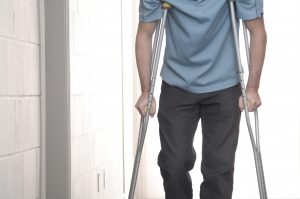Not all artificial hips fail. Many total hip replacement surgeries are successful. Unfortunately, artificial hips, particularly “metal-on-metal” hips, have “failed” at a rate much higher than previous artificial hip systems, whose components typically consisted of a combination of metals, plastics, and ceramics. The metal-on-metal design placed a metal ball or head directly into a metal acetabular cup. By using a metal cup and a metal ball, these artificial hips forced metal to rub against metal with the full weight and pressure of the human body. As long as the metals held up, all would be well. But it turned out that this intense pressure and movement often caused the metals to grind and deteriorate, and too often releasing metal particles into the surrounding tissue and into the bloodstream. In other artificial hip failures, such as with the Stryker LFIT v40, femoral heads can malfunction due to a failure in the taper lock. The taper lock is the part of the hip prosthesis that connects the femoral head to the stem. This can cause the neck on the femoral stem to grind down (sometimes referred to as “penciling”) and can even lead to a full disassociation (more on that below).
In still other artificial hip failures, the plastic liner (between the cup and ball) deteriorates and causes the total artificial hip system to fail. Polyethylene liners are very important in an artificial hip because over the years, it will serve as a buffer between the metal cup and also the metal femoral head or ball, so it can protect against excessive grinding of the hip components. But the studies have shown that Exactech hip plastic liners have been breaking down and showing signs of premature wear.
Please note that with any hip replacement surgery, there will be a period of rehabilitation. Even with great surgery results, the patient will suffer some soreness, stiffness, and a period to regain strength, mobility, and comfort. From the hundreds of people I have spoken with over the years who have undergone hip replacement surgery, even successful hip replacements do not turn you into a completely pain-free eighteen year old athlete.
For many patients, however, particularly those who received the metal-on-metal hip, there may come a point when they wonder if their artificial hip has failed. But given that all hip surgeries initially come with some discomfort and pain, how do they know if their hip has failed.
Let’s start with the basics:
What Is an Artificial Hip Failure?
 Artificial hips fail in several ways:
Artificial hips fail in several ways:
- Pain. This would be pain that lingers after the period of rehabilitation, or which arises months or years after the implant surgery. There is no marker for the precise amount of pain necessary to define a failure. If you are in pain, you need to assume that something is wrong and you need to schedule an examination.
- Swelling. The area around your hip replacement should not swell after the period of surgery and rehab is past. Swelling is a sign of a problem.
- Metallosis. This is the build up of metal levels in the blood and/or in body tissue. When a metal-on-metal artificial hip cup and ball grind together, tiny shavings can be released into the body, elevating metal levels. A simple blood test can identify metallosis.
- Loosening components. This is when a component like the acetabular cup has become loose and shifted or moved. It can hurt (see #1).
- Disassociation. In some cases, the femoral head and stem actually separate or break apart. In these cases, the hip and the leg are no longer connected. This can be caused by (for example) corrosion in the V40 femoral heads.
- Inflammation of tissue. This is where the hip area becomes swollen, warm, red, and often painful, as a reaction to the hip failure and/or as a result of infection.
- Pseudotumor. This is abnormal tissue growth that occurs as a reaction to metal particles being released near the site of the hip replacement. A pseudotumor is noncancerous. Pseudotumor does not always cause pain or other noticeable symptoms.
- Sounds. Other the years, several clients have reported that their hip has begun to make ominous sounds, such as grinding, whistling, popping, or thumping. Your artificial hip should not make noises.
Understand that with most hip failures, several of these conditions may be present, not just one. You may have pain, and swelling, and loosening components. Sometimes you may have all the symptoms.
What Might Artificial Hip Failure Feel Like?
- Pain. This is nearly always the first red flag. With artificial hip failure, there will likely be unusual pain and discomfort. As doctors like to say, “always listen to your body.” If something doesn’t feel quite right, it may not signal artificial hip failure. But it could.
- Popping sounds. I’ve had people tell me that their failing artificial hip actually made noises. The popping sound typically comes from a component that is loose or becoming dislocated. It often occurs with pain.
- Swelling or heat coming from the hip area. A sign of infection.
- Uncertainty. The hip feels insecure, as if the person’s leg may “give out” while walking or standing. In other cases, the hip feels as if it is locking up on the person.
- (Almost) nothing at all. Oddly, with some artificial hip component failures, you may not notice symptoms. This is when an artificial hip failure can be most frustrating; something is wrong, but you can’t detect anything serious. For years, one person I spoke with did not feel abnormal pain, but only some discomfort after walking for long periods on hard surfaces (like asphalt). The blood tests showed slightly elevated metal levels, but not outrageously high numbers. After several years, the pain grew incrementally, and the patient eventually chose revision surgery. The revision surgery revealed a very loose cup, dark metallic fluid, inflamed tissue around the hip, and other problems. Clearly the artificial hip components had failed, and revision surgery was necessary, even overdue. But the individual for years believed everything was “good enough.”
- Other sensations. The human body can simply react in all kinds of ways. If the feeling is unpleasant, something may well be wrong.
Despite all this unpleasantness, there is no need to panic. Panic is not good for anyone. But I do believe you must take ownership of your medical care. If something “does not feel quite right,” schedule an appointment with your orthopedic surgeon. Ask questions. Ask for a blood test. Ask more questions. Keep a symptoms journal, which I wrote about here. Stay after it.
And call me if you have legal questions: 919.334.6277.
No specific client information was used in writing this article. And of course, I am no doctor, and this is not medical advice.
 North Carolina Product Liability Lawyer Blog
North Carolina Product Liability Lawyer Blog



